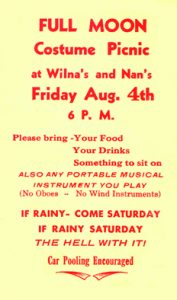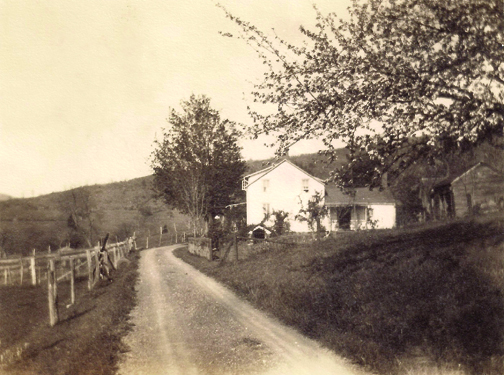
Road to the old farmstead, site of many Woodstock festivals
No one had ever seen so many cars inching their way along the normally quiet country roads. Certainly not the deputy sent out by the county sheriff to impose some order on the tangled traffic. Everyone seemed to be heading in the same direction, descending upon an old farmstead where the sounds of music and high spirits were already echoing across the meadows. It was apparent that a major event was in progress, though the real significance of this joyous gathering in the boondocks of rural New York State would not be clear until much later. . . .
If this description conjures up images of “Woodstock, 1969,” you’re on the right track. Woodstock it was, but the actual year was 1938, and the epic musicale generating all the excitement was a fundraiser to benefit the Woodstock Art Gallery. At the center of this late afternoon costume party, which lasted until the full moon set just before dawn the next morning, were two of Woodstock’s most loveable eccentrics, Wilna Hervey and Nan Mason. Actresses, artists, erstwhile farmers, and life partners Wilna and Nan were also among the Woodstock community’s best-known and most exuberant party hostesses. While this early September costume “picnic” was the largest and most ambitious soiree they’d ever thrown, it was far from their first. And it certainly wouldn’t be their last. Wilna and Nan’s first Full Moon party would, in fact, become an annual event for more than two decades and enter into Woodstock legend.

Wilna (far right) and Nan (second right) at the Maverick Festival, 1924
Staging big fundraising bashes under a full moon, with lots of music and rivers of free-flowing liquor, was already a well-established Woodstock tradition when Wilna and Nan embraced it as their own in 1938. As far back as 1915, Woodstock’s fabled series of annual Maverick Festivals had begun when Hervey White, the “first hippie” and one of the art colony’s founders, hosted the first such event to raise money to dig a well. White’s colorful costumed Maverick Festivals continued every year until 1931, by which time they had grown in size and popularity (and notoriety) to such an extent that the local authorities deemed it prudent to shut them down. None were more crestfallen to see their beloved Maverick Festivals come to an end than Wilna Hervey and Nan Mason, who had attended their first festival as a couple in 1924, wearing their signature clown costumes, and never missed any of the subsequent events. So, when the two women decided to entertain their friends and neighbors with a large open-air costume party on the grounds of their farm in late summer 1938, they did so as much with the intention of reviving a popular Woodstock institution as raising money for the local art gallery. The large and enthusiastic turnout they got that summer not only showed they were not alone in missing the old Maverick Festivals but guaranteed that the Full Moon Party would be back for an encore, again and again.
For Wilna and Nan, entertaining—in every sense of the word—was in their blood. It was the entertainment industry, specifically the movies, that had brought them together. Wilna, who stood six foot three and weighed upwards of three hundred pounds, was a silent film comedienne when the girls first met on a movie set outside Philadelphia; Nan’s father, Dan Mason, was Wilna’s movie co-star. As the daughter of a veteran character actor and a mother who sang in burlesque as “Millie la Fonte,” Nan, a very tall woman herself, enjoyed donning costumes and performing as much as Wilna did. Both of the “Big Girls” (as their friends called them) were accomplished musicians and delighted in performing quaint and witty songs for their friends. Toting a ukulele everywhere they went, they often sang for their supper at dinner parties and occasionally went out to local taverns on weekends to entertain the locals with their vocal renderings in two-part harmony. Their desire to perform was as irrepressible as their passion for throwing parties, and the two impulses were, like the girls themselves, inseparable.

Invitation to a pre-1969 Woodstock festival
Surprisingly, considering their enduring reputation as bacchanals, Wilna and Nan’s Full Moon parties were always officially billed as “family picnics,” with attendees welcome to bring their children. And in the late afternoon, when the family groups arrived and set up their campfires to cook their suppers, the proceedings were still pretty tame and family-friendly. It was only later, after a parade and the judging of costumes, that, as the sun set and the moon rose, the real howling began. By all accounts, the volume of alcoholic beverages consumed at these affairs was prodigious. In the mysterious semi-darkness—the only lights were the bonfires and the moon—any inhibitions brought to the party soon melted into the shadows. With the guests bringing along a wide variety of musical instruments, impromptu ensembles and small orchestras came together and performed, inspiring spirited singing and dancing. Some performances were planned ahead of time and rehearsed to perfection; others were spontaneous. It is remembered that at one of the parties a celebrity guest—internationally famous dancer Paul Draper—began to improvise a tap dance routine to the lively music. Several other guests ran to their cars and turned on the headlights to illuminate his performance.
From their first event in 1938 to the final soiree held sometime in the early 1960s, Wilna and Nan’s summer Full Moon party was the most anticipated and well-attended social event of the Woodstock community. With the goal of fundraising always on their minds, Wilna and Nan knew that the more guests they invited, the better. Not only did they invite virtually everyone they knew, with some family and friends and celebrity guests coming a distance to attend, but they also urged their friends and acquaintances to bring their friends as well. Woodstock’s notoriously eclectic mix of creative talents and unconventional types manifested itself at every gathering. One very senior Woodstock resident still takes impish delight in remembering how several starched and ironed executives from the newly opened IBM plant in nearby Kingston fled the Felliniesque proceedings at one party “with their minds blown.”
The last event to be written up by the local press occurred in 1959, not on the occasion of the August full moon but in celebration of the Fourth of July. Perhaps sensing that time and ill health would soon bring an end to their seasonal high jinks, the Big Girls pulled out all the stops on this occasion. They invited more people than ever, stretched garlands of colored lights through the trees, and employed an announcer for the grand costume parade and a panel of judges to award prizes. In addition to the usual jazz jam sessions and folksong hootenannies, the crowds were also entertained by a professional opera company. That they had outdone themselves was evident in the comment of a local reporter who wrote appreciatively that they had really kept alive the “old Maverick spirit.”
By the 1960s, both Wilna and Nan were feeling the weight of years, with Wilna now leaning heavily on two canes to walk even short distances. Their days of hosting big wild parties were over. As the famous Woodstock Music Festival came and went in that legendary summer of 1969, the former Full Moon Party hostesses, now in their seventies, spent much of their time sitting quietly, posing for a portrait. We don’t know how much the Big Girls knew about the “Three Days of Peace and Music” on Max Yasgur’s farm in Bethel that August. At least some of the music of the day must have seemed as alien to them as it did to other members of their generation. But if they watched any of the TV coverage, they must have been delighted to see a familiar sight—crowds of blissful young hippies grooving to the music in a pasture without a care in the world.
~ Joseph P. Eckhardt, author of Living Large: Wilna Hervey and Nan Mason


0 Comments